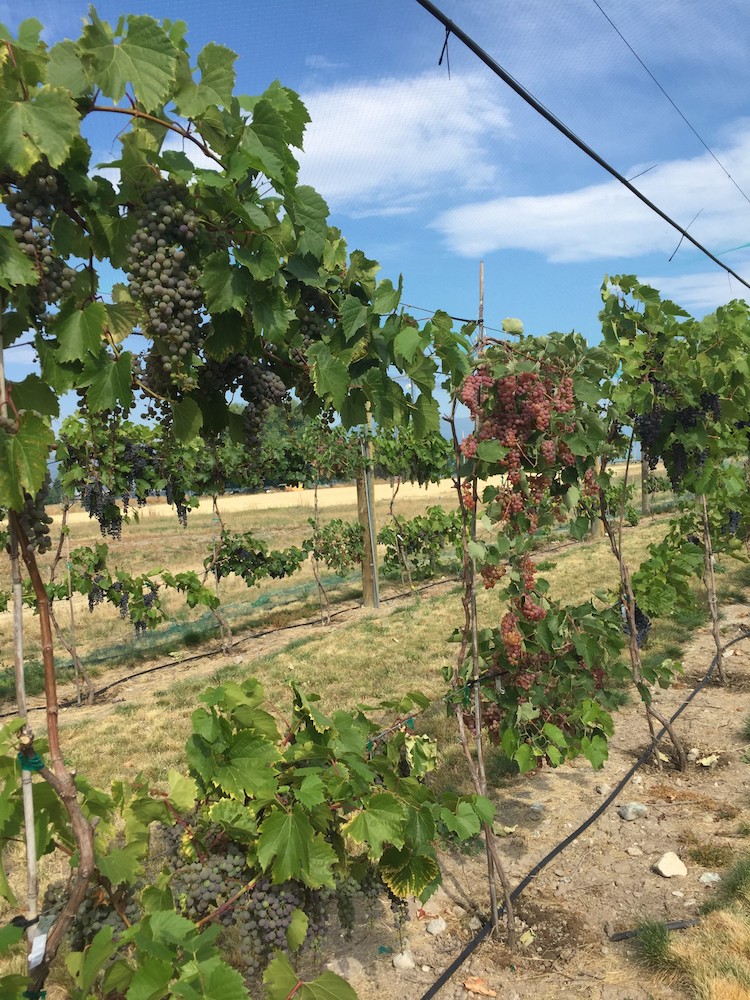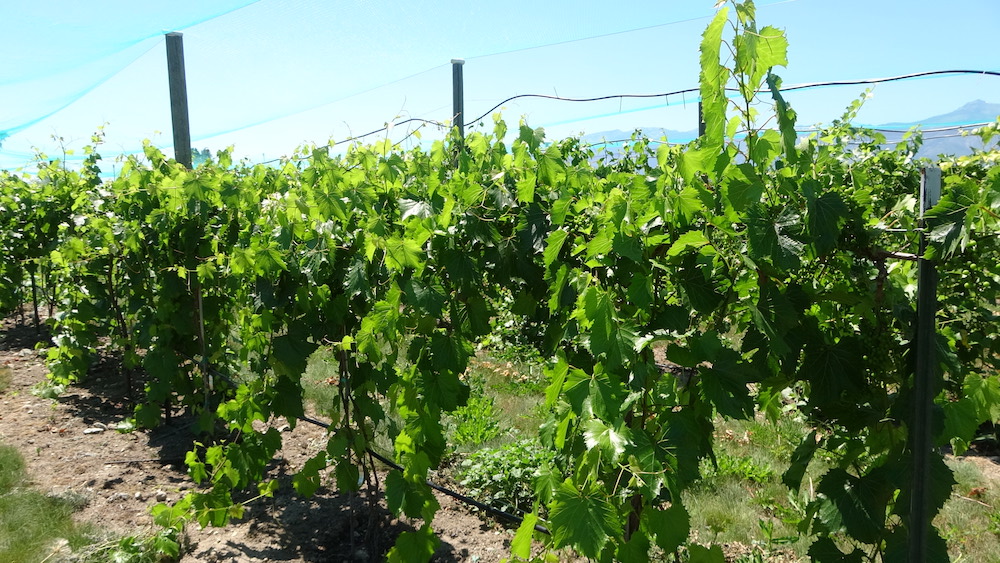Vineyard Irrigation
WARC's research vineyard features a few different kinds of irrigation, including drip lines along the base of the trunks, a drip line
While all grapevines need some form of water, the water needs of young vs. old vines, throughout the season, different cultivars, and vines planted in different climates and soil types can differ greatly. Since cold-hardy grapes have been mostly grown in the relatively wet midwest there’s little research-based information on how much water is required. Based on V. vinifera (european wine grapes), it’s likely that cold-hardy grapes use a lot of water.
How Much Should You Water in Montana?
Young Grapes (1-2 years old)
Young grapes — that is, within their first two years/growing seasons — should receive about .5 to 1 inches (5-10 gallons/vine/week) of water per week. Since the root system is small and shallow at this stage, watering can be more frequent and shorter duration. During rainy months and regions, you can reduce your irrigation schedule to account for any excess water received through rain.
Mature Grapes
Older grapes — that is, vines with established trunks and canes, likely producing fruit — vary more with regards to irrigation needs, especially at different stages of the growing season. You might find growing resources from other regions of the country (and world) warning against overwatering, as this can encourage more vegatitive growth in older vines. But in Montana’s typically hot and dry summers (depending on your region), you will likely find that this is less of an issue, especially if you have chosen a site with well-draining soil. Regardless of the system you choose, you will want to make sure that water is saturating the root zone, taking care to research exactly how much water your vines will need based on their cultivar and your soil type (e.g. sandy soils will need more frequent watering). This article on irrigation basics from Washington State University’s Extension program is a great place to start for understanding how grape vines use water at different points during the growing season and how to manage your own irrigation to optimize for quality harvest.
The basic principle that can inform irrigation is vines’ water use, which is driven by the amount of leaf area and the rate the leaves are losing water (evapotranspiration). As shoots expand and add leaves during the season, water use will increase. Water loss from the leaves will also increase when it’s hot, dry, and/or windy. While water use will be relatively low during cooler periods early in the season (typically in the range of 10 gallons per vine, per week), they can reach 30-40 gallons per week in hot, windy weather later in the season.
So, how do you decide how much water to use? Large commercial vineyards will estimate water loss rates based on evapotranspiration rates (available using evapotranspiration-measuring weather stations or online maps) and a crop coefficient that accounts for the size of the vine canopy (leaf area). This approach may be too complex for smaller vineyards.
Simpler alternatives include watering to maintain soil moisture, avoiding signs of plant drought stress, or rough estimation. The approach for maintaining soil moisture is to keep the soil moist at 18-24 inches deep. Moisture at depth is critical for roots to be able to grow into deeper soil and access more nutrients. This can be done by installing soil moisture sensors under the vines (near an emitter if using a drip system). If purchased separately, the digital meters (which allow you to take readings from the sensors) will run between $200 and $300, while the sensors will run ~$40 each. If purchased as a package, you can find slightly cheaper prices. You can use the readings from the sensor to determine how long to irrigate to get water to that depth and apply irrigation when the sensor indicates that the soil is getting dry.
Rough estimation can be made for grape water use. Mature vines do well without irrigation in the upper midwest where they recieve 3-5 inches of rain per month from May to September. Use your vine spacing to calculate how many gallons that is per week. For example, if vines are planted at 6 ft. apart in the row, you could assume that the roots occupy a 6 x 4 ft. area (24 sq. ft.). 4 inches (or ⅓ ft) of rain in that area equals 8 cubic feet or about 60 gallons per month of water. Dividing by 4 weeks, provides a rough estimate of around 15 gallons of water per vine per week. In the vineyard at MSU-Western Agricultural Research Center, we use this value as our baseline for mature vines (3+ years old with trunks >1-inch in diameter). We also monitor soil moisture and increase irrigation by 10-25% during hot periods (high temps >90°F).
It is important to note the risks of both over- and under-watering in your vineyard. Overwatering early to mid-season can encourage overly vigorous vegetative growth and overshading in your canopy. Overwatering later in the season, especially after fruit set, can negatively affect the quality of the fruit, essentially diluting the juices in the berries. Underwatering, however, can also negatively impact fruit set, causing vines to put out fewer and smaller clusters if they are under water stress early in the season. While grapes are known to be relatively low-maintenance when it comes to watering, it is still possible to under-water severely enough that your vines are under serious water stress at any point during the season. Be sure to increase your watering to compensate for any particularly hot, dry, or windy weather, as is common during Montana summers. This article from Cornell University, while not focused on cold-hardy cultivars, is a great resource for helping you recognize the signs of drought stress in your vineyard, many of which are reversible should you correct your watering issues promptly.

WARC usesdrip systems both on the ground (picture above), and elevated above the ground on the first trellis wire (pictured at top of page).
*Note: Diluting the berries can sometimes be a good idea for certain cold-hardy varieties, as it can help dilute the sugar and acids (along with flavor), both of which can be especially high in grapes like Frontenac. This, however, is something growers may want to avoid experimenting with until they’ve had a few seasons of harvest under their belt and have a good understanding of their crop’s typical chemistry.
Irrigation Systems
There are a few different ways to go about irrigating your grapes, but the majority of methods employ some form of drip system. Drip systems are preferred, as they deliver water directly to the root zones, rather than dispersing over a large area. Drip systems also avoid adding excess moisture to the canopy, which is common in sprinkler systems and creates an ideal environment in which disease can spread. Many have found success using a system that either incorporates a drip hose that lies directly on the ground or hangs a few feet overhead, ideally mounted to the first wire in your trellis system. Timers can also be extremely helpful for ensuring your vines are receiving water on a specific schedule. But as with anything, the more advanced your irrigation system, the greater the cost to install. You will want to measure your own needs for convenience, cost-effectiveness, and compatibility with your trellising when choosing the best irrigation system for your vineyard.


